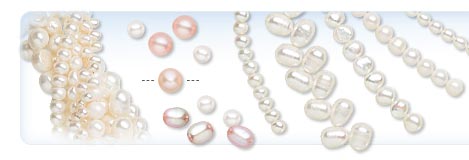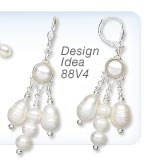Cultured Freshwater Pearls
4B16 |  |
Pearls Through History
No one really knows who the earliest people to collect and wear pearls were. It is believed by some that an ancient fish-eating tribe, perhaps along the coast of India, initially appreciated the shape and luster of saltwater pearls, which they discovered while opening oysters for food.
Pearls are regarded as one of the most valuable gem materials, because they do not require any processing. They come from the water showing full gloss, the desired luster. They have been used as adornment in jewelry for almost 6,000 years. The unique characteristic and rarity of pearls has been a major reason for their great value.
Natural and Cultured Pearls
Natural pearls are formed when an irritant, such as a grain of sand, finds its way into an oyster (or mussel) without any human intervention. When you come across these mollusks in the "wild" you will seldom or rarely find a pearl of commercial value inside their shell.
Cultured Pearls are formed in much the same way.
On a cultured pearl farm, a specialist will inoculate the oyster with a modified syringe, which injects tiny seeds of glass, sand or mother-of-pearl into the interior of the oyster.
To protect itself, the oyster begins to cover the irritant with a protective surface, called nacre. This nacre has a unique natural luster, and varying colors. As the oyster lives, it continues to cover the irritant, gaining in size and creating a larger pearl.
Not just one pearl comes out of each oyster. Many freshwater pearls grow in one oyster.
Oysters on pearl farms are meticulously cared for. The inoculated oysters are put into small mesh baskets in clean ponds. They are strung on lines, spaced at intervals and suspended at optimum depth for warmth, light and absorption of nutrients. Each day, every oyster shell is checked for health. If one shows any indication of ill health or distress, it is immediately removed from the pond. Its ill health could affect the entire production of the pond within one day.
Oysters feed on a mixture of fermented soy, crushed grains, rice, and secret ingredients exclusive to each pearl farm, and based on years of experience. It smells terrible!
Age, no stress and quality of life create a large size pearl. The longer the pearl is in the oyster, the thicker the nacre.
Quality - What's Good, What's Not?
Surface - Nacre. The typical pearly luster is called "orient," and is produced by overlapping platelets of calcium carbonate and nacre. This formation causes light refraction, which is observed as spectrum color on the pearls surface.
Optimum luster is what's called an "egg yolk" effect, where the luster is seen as a good interior separation from the outside.
Uniformity, pitting, wrinkles. The best pearls are those with uniform shape, the true rounds being one of the most valuable. When buying strands of pearls, look for well matched luster, color and shape. Also look not only at the center of the strand, look down the strand to the ends. Many clever stringers place the best beads in the center of the strand, and the less expensive or lower grades are placed on the ends where most people won't notice.
Pitting indicates irregularities of the surface or nacre. Surface pitting reduces the grade. Wrinkles are formed during the pearl's growing cycle and will reduce the grade of the pearl.
Color. The most valuable freshwater pearls are the natural pure white, with a touch of pink nacre luster. Other naturally occurring colors are the beautiful range of pinks and peach-orange colors. Designer colors of freshwater pearls are enhanced to blend with fashion accessory colors.
Caring for Pearl Jewelry
When taken care of properly, pearls will last for many generations.
Because pearls are relatively soft, ranging 2.5 to 4 on Moh's scale of hardness (1-10, 10 is the hardness of a diamond), they should be stored in a cloth pouch or wrapped in a piece of soft cloth. Since most stones and metals are harder than pearls, storing your pearls together may scratch them. Most pearls of value are knotted between each pearl to protect them from continual rubbing against one another.
They can be damaged in other ways:
- Dressing - Put on pearls after you have applied your makeup, hairspray and perfume. Chemicals in these products can be harmful.
- Remove pearls before bathing or swimming. Chemicals or minerals in the water may harm the pearl or deteriorate the cord they are strung with.
- After you have worn your pearls, wipe them gently with a soft clean cloth. Over time, the slight acid in your perspiration can have an abrasive affect on them.
- If you find it necessary to clean your pearls, do not use ammonia-based cleaners, detergents, bleaching agents or powdered cleaners. Don't use abrasive materials, scouring pads or stiff brushes. Gently wash in water with a mild soap and dry them with a soft cloth. Lay necklaces flat to dry. Do not hang or wear them when wet, since this may stretch the cord.
- Don't keep pearls in a sealed plastic bag. Pearls are organic and need to breathe. Long exposure in sealed bags, in direct heat or sunshine may dry, crack or discolor pearls.
How to tell a Genuine Pearl from an Imitation Pearl
There is a simple test that the layman can do when wanting to test for authenticity. Train yourself with a pearl that you know is genuine and one you know is not.
To test, simply rub the pearl on the smooth surface of your tooth. The imitation will feel smooth as it rubs across the tooth surface. On the genuine you will feel a slight resistance; some describe it as slightly gritty. Train yourself to the sensation and be a more educated buyer.
Pearls benefit from being worn; the warm body temperature and natural oils from the skin enhance the luster. Enjoy your pearls for what they are, true organic gems.
Cultured Freshwater Pearl Grading Guide
Different companies have different standards for pearl grading, our pearl grades are those used by the mainland Chinese pearl traders. The Chinese pearl grading standard is as follows:
 |
A Grade:
|
Extremely well shaped, white, high luster, very minor surface blemishes.
|
 |
B Grade:
|
Well shaped, white to light cream, high luster, minor surface blemishes.
|
 |
C Grade:
|
Irregular shape, off-white, medium luster (may be non-uniform), surface is irregular.
|
 |
D Grade:
|
Same as C grade, but one or more of the characteristics are excessively bad (such as areas of no luster or wrinkled surfaces).
|
F Grade:
|
For promotional purposes only. Not suitable for jewelry. Most of this grade is ground up into pearl powder (used in cosmetics).
|
Some pearls fall between grades and are given mixed grades (A-B grade). Also, a pearl with A grade luster and C grade surface may be given a compromise B grade, though this type of pearl is avoided by Fire Mountain Gems as much as possible.
No comments:
Post a Comment